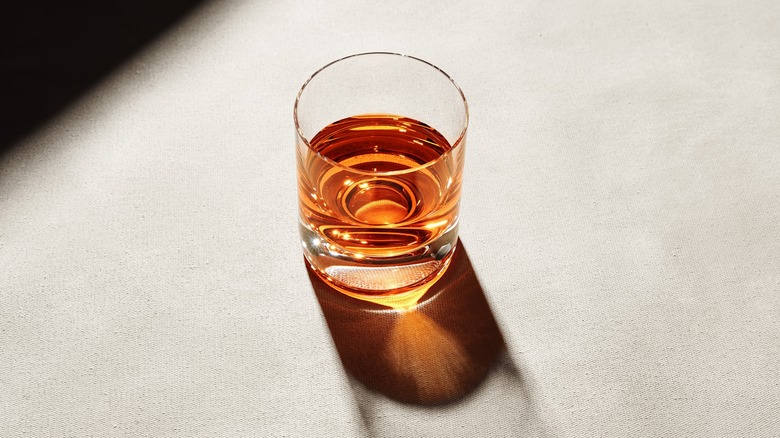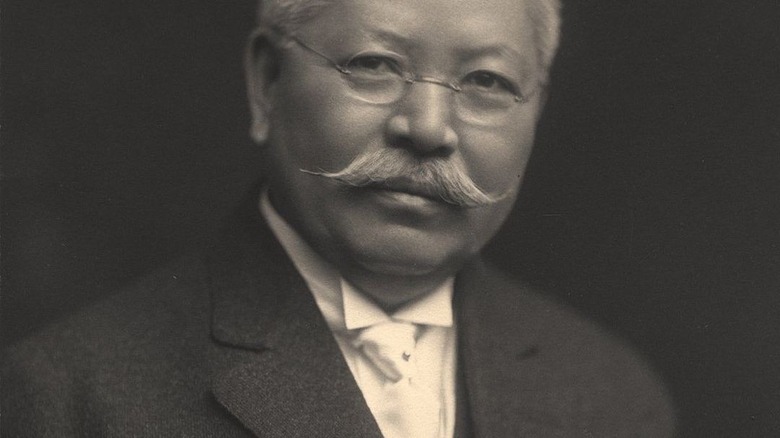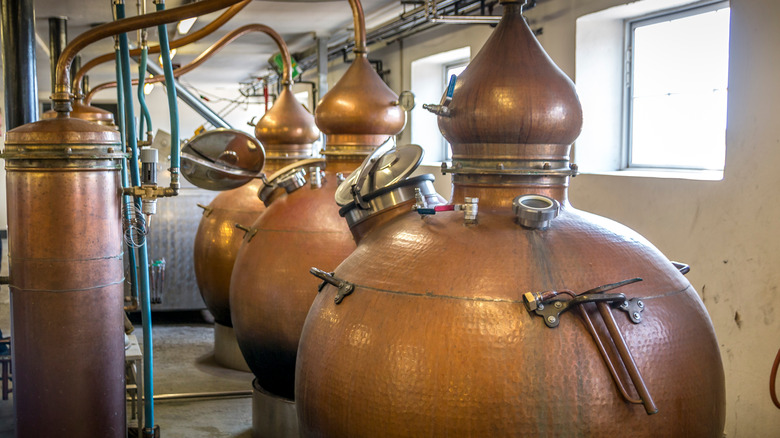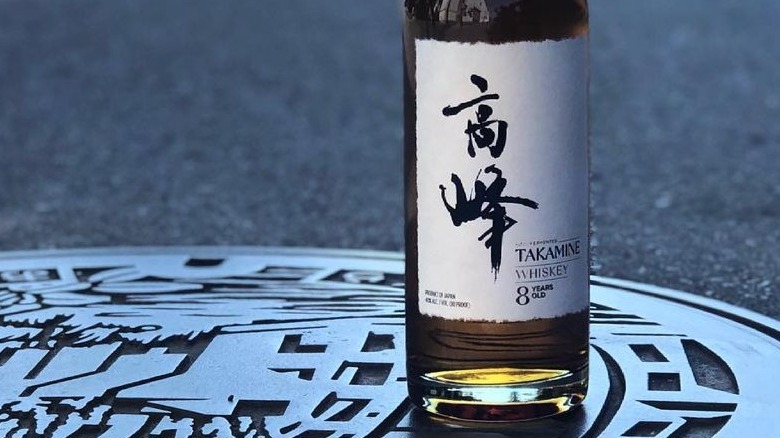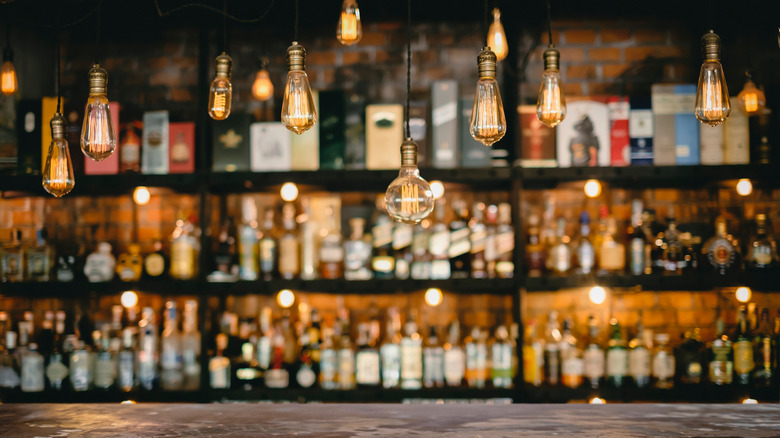What Is Takamine Whiskey And Why Is It So Unique?
A new whiskey has been delighting spirits experts with its unique flavor profile: the Takamine whiskey. The alcohol stands out from other whiskeys (and whiskys) for a number of reasons — one being the way it is produced. Takamine whiskey is fermented with koji, a mold that's been a beloved ingredient in Japan for centuries and, more recently, by chefs in the U.S. and beyond.
Koji-fermented whiskeys are not a novelty in Japan, where the mold is also used to brew sake and shōchū, but Takamine whiskey is made with 100% barley instead of rice (via Punch). Shinozaki Distillery, based in the Fukuoka prefecture of Japan, creates this expression by fermenting a barley base with koji instead of malting it, as is done with typical malt whiskeys.
After undergoing multiple parallel fermentation, the ferment is distilled twice and then aged in new oak and ex-bourbon casks for eight years, according to Honkaku Spirits, the importing company for the liquor. Upon the stateside debut of the 80-proof whiskey last year, it took home a Gold Medal at the San Francisco Wine & Spirits Competition (via The Whiskey Wash).
How Takamine whiskey got its name
Besides its production process, Takamine whiskey caught the attention of critics because of its unique story, which goes back 130 years. The liquor gets its moniker from Jokichi Takamine, a Japanese scientist who almost redefined the modern American whiskey scene. Born in 1854, Takamine hailed from a samurai family on his father's side and a sake-brewing family on his mother's side, according to Punch. Thanks to the latter, he grew up with an intimate knowledge of koji fermentation. Takamine, who specialized in chemistry, earned a scholarship to study abroad and ended up at the University of Scotland, where he specifically researched whiskey production and discovered that fermenting with malt was significantly less efficient than doing so with koji (via Forbes).
The Japanese mold serves as a catalyst to directly convert starches into sugar, so the malting process is unnecessary. As Punch explains, using koji is also more economical and convenient because it only takes at most two days to propagate it, whereas malting takes at least a week. The fermentation results in fewer volatile compounds so distillation involves less cutting, which means less waste.
The history of Takamine whiskey
After Takamine returned to Japan, he eventually perfected a whiskey production method with koji at the center—dubbed the "Takamine process," per The Whiskey Wash. He married an American woman and relocated to Chicago where he established his own distilling company in 1890. Takamine began working on adapting his method for commercial purposes and caught the attention of the Illinois Whiskey Trust, who invited him to Peoria. He managed to obtain patents for his approach in several countries including the U.S., Canada, France, and Belgium (via Punch and Forbes).
It is purported that the workers and owners of the malt factories in the area — then home to 12 distilleries — viewed Takamine's innovation as a threat. The Whiskey Trust alone was responsible for 95% of U.S. whiskey production (which would be the reason for its downfall). As alleged in Forbes, people broke into Takamine's distillery at night as an attempt to murder him in 1891. He evaded them by hiding in the basement, but the building was burnt down to the ground.
Not to be deterred, Takamine continued with his project and eventually produced a whiskey using his method through the Whiskey Trust in December 1894. However, as Peoria Magazine explains, the Whiskey Trust had been going through an antitrust case since 1892, and soon after Takamine's breakthrough, the Whiskey Trust was dissolved, ending Takamine's contract. His company lost to receivership, per Punch, Takamine decided to leave the world of whiskey-making for good. He would pivot to the medical field, and not long after licensing his Takadiastase enzyme, would isolate adrenaline.
What does Takamine whiskey taste like?
Though Takamine's whiskey never made it out to the American public, it has found new life through the partnership between Michiaki Shinozaki of Shinozaki Distillery and Christopher Pellegrini and Stephen Lyman, two American ex-pats in Japan and the team behind Honkaku Spirits.
Why are whiskey experts raving about this new expression? According to a review from Imbibe Magazine, its flavor is unlike anything else in the whiskey category — boasting a "rich and robust" taste with "funky earthiness" that begins with a "lovely interplay of barley and honeyed sweetness," proceeds into notes of saltiness, and then finishes in "walnut-like dryness." The same reviewer recommends enjoying the spirit neat or with just a little ice.
The New York Times describes Takamine whiskey as having a "slight mushroom aroma." This hint of savory umami flavor comes from the koji fermentation, which produces a higher amount of amino acids (eight times more than beer, three times more than wine), as Pellegrini explained to Forbes.
Where to buy Takamine whiskey
The whiskey that Takamine dreamed of making is readily available for American liquor enthusiasts to try. It's currently distributed by Winebow, a leading national wine and spirits distributor. As its executive vice president of spirits Richard Driscoll told Craft Spirits Magazine, [Winebow is] "thrilled to bring Jokichi Takamine's legacy of whiskey-making back to the U.S." through this "exceptional product with an incredible story."
For a 750 ml bottle, the Takamine 8 Year Whiskey retails for $99 and can be purchased online and in stores through retailers such as Total Wine & More and ShopWineDirect. The spirit is available in various states across the U.S.: California, Connecticut, Delaware, Florida, Georgia, Illinois, Maryland, Minnesota, New Jersey, New York, Pennsylvania, South Carolina, Washington, Washington, D.C, and Wisconsin (via The Whiskey Wash).
Takamine may not have found success in the spirits industry during his lifetime, but his innovative research has led to the creation of a unique whiskey that's making waves over a century later.
